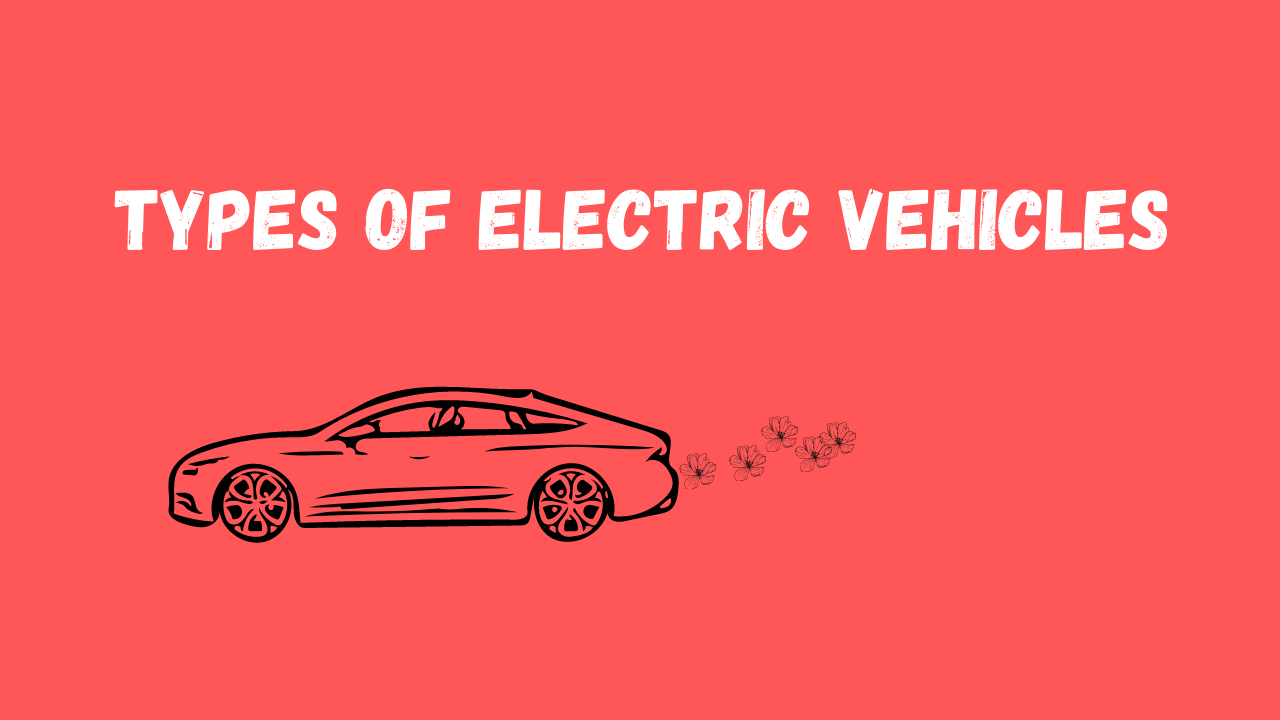Electric vehicle usage is increasing day by day. Electric vehicles are becoming popular because of multiple reasons. Reasons such as environment friendly, low maintenance cost, etc.
Electric vehicles are rapidly making their way to the mainstream. Aggressive goals such as a complete shift to electric vehicles by 2030, taken by the United Kingdom are clear signals that shift towards electric vehicles is faster than we think.
Although electric vehicles are showing rapid growth and penetration, understanding of electric vehicles and their types is still new to the majority of the world population. This article is an effort to spread knowledge about types of electric vehicles.
Electric vehicles come in multiple types as do conventional gasoline vehicles. We will discuss them one by one.
Table of Contents
Types of Electric Vehicles
Battery Electric Vehicles(BEVs)
Battery electric vehicles, also called BEVs or EVs in general, are fully electric vehicles. The energy powering BEVs is electric energy only, no gasoline is used. A rechargeable battery pack is used for the storage of energy. Energy stored in the battery pack is used to power the motor, which indeed powers the vehicle.
BEVs are also known as plug-in EVs as they use an external electrical charging outlet to charge the battery. Charging outlets can be classified based on the charging speed.
| Charging Station Type | Rate of Charging |
| Level 1 Charging(120 Volt Charging station) | 3~5 Miles per hour |
| Level 2 Charging (240 Volts Charging Station) | 15~35 Miles per hour |
| Level 3 Charging (480 Volts Charging Station) | 120~150 Miles per hour |
| Rapid Charger Station | 30 minutes Full Charge |
| Home Chargers | Varied rates(generally over night charge |
The penetration of BEVs in the global market is rapidly increasing.BEVs have multiple benefits contributing to their recent popularity.BEVs are environment friendly as there is almost no emission involved in operating BEVs.As compared to Internal combustion engine BEVs do not involve any fuel burning, hence no emissions. Concerns over climate change are relevant today more than at any time in human history, So shift to BEVs seems to be the most logical decision at this point in time.
Also, BEVs have a minimal maintenance cost, since BEVs do not have multiple moving parts as conventional IC engines do. The absence of multiple moving parts avoids any repairs or replacements due to wear and tear.
BEVs might be expensive to purchase but in the long run, it proves to be cheaper because of lower maintenance and running cost.
BEVs are capable of running 200 KM to 500 KM in a single full charge. It varies from model to model and manufacturer to manufacturer.
BEVs in Market
- Tesla Model 3
- Mercedez Benz EQC
- Tata Nexon EV
- MG ZS EV
- Tata Tigor EV
- Hyundai Kona Electric
- Mahindra E Verito
- BMW i3
- Chevy Bolt
- Chevy Spark
- Nissan LEAF
- Ford Focus Electric
- Hyundai Ioniq
- Karma Revera
- Kia Soul
- Mitsubishi i-MiEV
- Tesla Model S
- Tesla X
- Tesla Y
- Toyota Rav4
- Volkswagen e-Golf

Plug-in Hybrid Electric Vehicles(PHEVs)
PHEVs are a combination of gasoline and Electric vehicles.PHEVs have a battery pack installed along with IC Engine but their power storage capacity is very less as compared to complete BEVs.As PHEVs operate on internal combustion engines as well. Hence its maintenance cost is not as low as it is for BEVs.
PHEVs have the plug-in option for External Electric Charging. Batteries also get charged through regenerative braking.
In PHEVs most of the work is done by an internal combustion engine, the electric power source is in a supporting role. Travel range for PHEVs on full electric charge varies from 20 KM to 80 KM. In fact, it is enough for intracity travel and is a good option for those with very little intercity or long distance travel.
PHEVs travel on electric energy and once battery energy drains, it switches to an internal combustion engine.
PHEVs give you the flexibility to use both electricity and gasoline as fuels, based on availability.
PHEVs in Market
- Chevy Volt
- Chrysler Pacifica
- Ford C-Max Energi
- Ford Fusion Energi
- Mercedes C350e
- Mercedes S550e
- Mercedes GLE550e
- Mini Cooper SE Countryman
- Audi A3 E-Tron
- BMW 330e
- BMW i8
- BMW X5 xdrive40e
- Fiat 500e
- Hyundai Sonata
- Kia Optima
- Porsche Cayenne S E-Hybrid
- Porsche Panamera S E-hybrid
- Toyota Prius
- Volvo XC90 T8
Hybrid Electric Vehicles(HEVs)
Hybrid Electric vehicles also use both electric power and gasoline as fuel.But in case of HEVs battery cannot be charged using external power sources.
Charging in case of HEVs is completely through regenerative braking.Also the storage capacity of battery packs used by HEVs is very less as compared to BEVs and PHEVs.
In case of HEVs range for electric power operation is 3 KM to 5 KM only.In case of HEVs Electric vehicle electric power is mostly used for starting vehicles only.
Hybrid Vehicles are majorly of two types
- Mild hybrids: Mild hybrids use a battery and electric motor to help power the vehicle and help the engine to shut off when the vehicle stops (such as at traffic lights or in stop-and-go traffic), indeed improving fuel economy. But Mild hybrid systems cannot power the vehicle using electricity alone. These vehicles generally cost less than full hybrids but provide less fuel economy benefit than full hybrids.
- Full hybrids: Full hybrids have larger batteries and more powerful electric motors, which can power the vehicle for short distances and at low speeds. A full hybrid might be costlier than mild hybrid cars but in return hybrid vehicles provide higher fuel efficiency than mild hybrids.
First HEV was introduced by Toyota in 1997.Toyota introduced it through Toyota Prius.Since then, the Toyota Prius has been the world’s best selling car and the most recognizable hybrid electric vehicle.
Biggest benefit of HEVs is improved fuel economy and reduced emissions.Although these benefits are more prominent in BEVs and PHEVs but still it calls for a considerable improvement.
Since HEVs does not have any external charging option,you need not to install or invest in any charging facility.
HEVs in Market
- Toyota Prius Hybrid
- Honda Civic Hybrid
- Toyota Camry Hybrid
Fuel Cell Electric Vehicles(FCEVs)
FCEVs are powered through hydrogen.Fuel cell electric vehicles are in the initial stage of development.FCEVs are powered through very promising technology.
FCEVs are better than internal combustion engines as they don’t have any harmful tailpipe emissions.They emit only water vapours and warm air.There are lots of efforts going on to make FCEVs commercially viable.
Fuel cell is a device uses hydrogen or hydrogen rich fuel and oxygen to produce electricity.One of the most common fuel cell used is PEM.PEM stands for Polymer electrolyte membrane.PEM consists of an electrolyte membrane sandwiched between cathode(positive electrode) and anode(negative electrode).
Hydrogen fuel is channeled to anode and at this stage catalyst separates positively charged electrons from positively charged electrons.Electrolyte membrane allows positively charged electrons to pass but does not allow negatively charged electrons to pass,forcing them to flow through an external circuit,hence producing electricity.
At the cathode, the negatively charged electrons and positively charged hydrogen ions combine with oxygen to form water (H2O) and heat.
FCEVs in Market
- Hyundai Santa Fe FCEV
- Hyundai Tucson/iX35 FCEV
- Honda FCX Clarity
- Roewe 950 fuel cell
- Toyota Mirai
- Riversimple Rasa
- Honda Clarity Fuel Cell
- Hyundai Nexo
- Toyota Mirai II
- Hyundai Xcient Fuel Cell – World’s first mass-production Fuel Cell commercial vehicle.

Comparison Table
| Parameter | BEVs | PHEVs | HEVs | FCEVs |
| Driving Component | Electric Motor | Electric Motor and IC Engine | Electric Motor and IC Engine | Electric Motor |
| Energy Source | Battery Pack | Battery Pack and Gasoline | Battery Pack and Gasoline | Fuel Cell |
| Electric Range | 200 KM to 500 KM | 20 KM to 80 KM | 3 KM to 5 KM | 200 KM to 500 KM |
| Emission Status | Very Less Emission | Medium Emission | Medium Emission | Very Less Emission |
| External Electric Power Source | Required | Required | Not Required | Not Required |
Reference





I have been browsing online more than three hours today, yet I never found any interesting article like yours. It is pretty worth enough for me. Personally, if all web owners and bloggers made good content as you did, the web will be a lot more useful than ever before.
I think other site proprietors should take this web site as an model, very clean and excellent user friendly style and design, as well as the content. You’re an expert in this topic!
Hey very nice website!! Man .. Beautiful .. Amazing .. I’ll bookmark your I’m happy to find so many useful information here in the post, we need develop more strategies in this regard, thanks for sharing. . . . . .
I am very happy to read this. This is the type of manual that needs to be given and not the accidental misinformation that is at the other blogs. Appreciate your sharing this best doc.
I have been exploring for a little bit for any high quality articles or weblog posts on this sort of space . Exploring in Yahoo I finally stumbled upon this site. Studying this info So i am happy to convey that I’ve an incredibly good uncanny feeling I discovered exactly what I needed. I so much for sure will make certain to do not disregard this web site and give it a glance on a relentless basis.
You made some really good points there. I checked on the internet for additional information about the issue and found most people will go along with your views on this website.
Im thankful for the blog article. Really Cool.
It’s best to participate in a contest for probably the greatest blogs on the web. I will advocate this site!
Fantastic post.Much thanks again. Really Cool.
I’m still learning from you, while I’m trying to achieve my goals. I certainly love reading all that is posted on your blog.Keep the posts coming. I liked it!